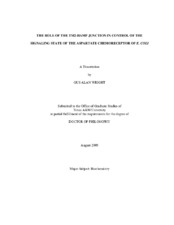| dc.description.abstract | The mechanism of allosteric coupling between the external ligand-binding domain and the internal signaling domain of bacterial chemoreceptors is poorly understood. Genetic, biochemical, and biophysical evidence suggests that transmembrane helix 2 (TM2) undergoes a piston-like displacement of approximately 1-3 Angstroms toward the cytoplasm upon the binding of aspartate to the Tar receptor. The signal is then transmitted to the cytoplasmic signaling domain via the HAMP domain, a conserved motif found in all methyl-accepting chemotaxis proteins (MCPs) and most histidine protein kinases (HPKs). HAMP forms a parallel four-helix bundle consisting of a dimer of two amphipathic helices (AS1 and AS2) connected by a flexible linker.
The MLLT sequence between residues Arg-214, at the end of TM2, and the conserved residue Pro-219, at the beginning of AS1 of the HAMP domain (the TM2-HAMP junction), is predicted to be able to form a helical extension of TM2. We hypothesized that perturbing the native secondary structure and/or the length of the TM2-HAMP junction would disrupt the ability of HAMP to communicate the input signal from TM2 to the kinase-control domain. To test this hypothesis, we designed two experiments. First, constructs were made in which 1 to 3 Gly residues were inserted between T218 and P219. Second, Tar variants were constructed in which 1 to 9 Gly residues were inserted between R214 and P219. The results suggest that increasing the length and flexibility of the TM2-HAMP connection tends to uncouple signal propagation between the TM2 and the HAMP elements and suggests that HAMP alone causes an inhibitory effect on the cytoplasmic signaling domain.
To determine whether the predicted helical register of the MLLT sequence is an important component of the propagation of the transmembrane signal from TM2 to the HAMP domain, we added and subtracted helical residues to the MLLT sequence. The results suggest that helical register and length of the TM2-HAMP junction are essential for optimal receptor function. | en |


